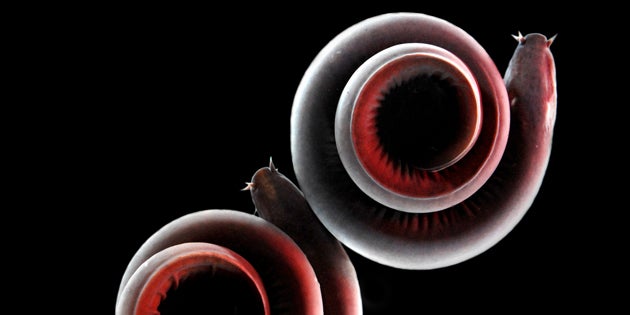When Andrew Clark began graduate school at the University of California, Irvine, his doctoral advisor introduced him to a tankful of mysterious jawless fish, called hagfish, which sat unnoticed in a corner of the lab. Clark soon began videotaping the feeding behaviors of the Pacific and Atlantic hagfishes and dissecting the mouthparts of preserved specimens. He became particularly fascinated by the eel-like fish’s unique ability to twist itself into knots.
As an assistant professor of biology at the College of Charleston since 2010, Clark has continued conducting research to better understand the biomechanics of jawless biting in hagfish. He believes the acrobatic habits of this bottom-feeding scavenger could lead to advances in the design and safety of ropes for climbers, soldiers and others who trust their lives to ropes.
Recently, Clark and his collaborator, Ted Uyeno of Valdosta State University, were awarded a $600,000 grant from the National Science Foundation to study the structural and functional properties of the tissues that support and control hagfish teeth, the material properties of hagfish skin, and the biomechanics of knot-tying in hagfish.
RELATED: Read about Clark’s biomechanics research with helmeted guineafowl.
The grant will allow the researchers to travel to places such as New Zealand and Japan to study special hagfish populations. Clark will also use some of the funding to pay undergraduate biology and physics students to assist with the research.
One focus of the project is to better understand the biological characteristics that enable the hagfish to knot its body, and to investigate how those same attributes could be carried over into practical applications that require knots that are strong but easily untied, Clark said.
“The different styles of knot formation are very important because some knots are more difficult to untie than other knots,” Clark said. “Knot-tying is used extensively in military, medicine, nautical environments and search and rescue.”
For hagfish, knotting is a means of survival. Because they have no jaws or other rigid structures, they lack the ability to tear large strips of food from a source using only their mouths. To compensate, they knot their bodies and use them as leverage to strip away pieces of food. Watch the video at the top left of this page.
RELATED: Watch a video (top left) of a hagfish knotting its body in order to feed.
Clark and Uyeno have observed thousands of hagfish feedings, always curious about the special composition of muscles, skin and cartilage that enables the animal to rotate and coil its body in such fluid motions.
In 2011, Clark and undergraduate colleagues at the College discovered that hagfish have loose skin. Clark likens the slack skin of the hagfish to baggy trousers, while the tight fitting skins of other fish – like tuna, sharks and salmon – resemble Spandex.
When they examined cross-sections of hagfish anatomy under microscopes, they also discovered that between the skin and the underlying layers of muscle lies a large open space. They theorize that this “subdermal sinus” and loose skin could be important to the hagfish’s knotting ability.
As they prepare to begin their three-year research project this fall, the researchers have been testing the loose-skin theory by recreating its characteristics with lengths of rope. They are using a specific type of rope called a kernmantle rope, which is often used in climbing and mountaineering because of its strength and flexibility.
Kernmantle rope – consisting of an inner bundle of smaller ropes wrapped in a woven exterior sheath – also happens to look a lot like a hagfish in terms of its design.
In some early experiments, Clark and Uyeno reconstructed two sections of rope – one with a tight outer sheath and one with a loose sheath. The results (need photo) were obvious, Clark said. The rope with the slack outer layer was much more flexible than the tightly wrapped one.
“By having loose skin you gain a lot of flexibility,” Clark said.







